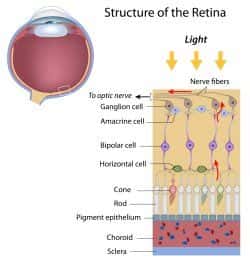Tired of squinting when you read? Add an eye exam to your list of New Year's resolutions.
Read more
Retinal disorders are conditions that affect the layer of tissue at the back of the eye, known as the retina. This important part of the eye responds to light and passes on images to the brain. All retinal disorders affect your vision in some way, but some can also lead to blindness.
Macular degeneration. Also known as age-related macular degeneration (AMD), this condition affects the center part of the retina, the macula. This area is needed for the sharp, central vision that is used during everyday activities such as driving, reading or working with tools. This condition is a leading cause of vision loss in people over the age of 60 years old. Treatment can slow the loss of vision, but it will not restore vision that has already been lost.
Diabetic eye disease. The high blood sugar (glucose) levels that occur with diabetes can also affect vision. One type of diabetic eye disease is diabetic retinopathy, which affects the blood vessels in the retina. This can lead to blurry or double vision, blank spots in the vision and pain in one or both eyes. Diabetics may also be at higher risk of developing other eye conditions, such as cataracts and glaucoma.
Retinal detachment. This medical emergency happens when the retina pulls or lifts off of its normal position. It can cause symptoms such as floaters in the field of vision, light flashes and the feeling of a “curtain” in the way of your vision. If not treated right away, a retinal detachment can lead to permanent blindness in that eye.
Retinoblastoma. This cancer of the retina is generally uncommon; although, it is the most common type of eye cancer in children. The cancer starts in the cells of the retina, but can spread to other parts of the body (metastasize).
Macular pucker. Scar tissue on the macula can make the central vision become blurry and distorted. Although the symptoms are similar, macular pucker is not the same as age-related macular degeneration. The symptoms of a macular pucker are usually mild and do not require treatment. Sometimes, the scar tissue can fall off the retina on its own, and the vision will return to normal.
Macular hole. This condition is caused by a small break in the macula, which leads to blurriness and distortion in the central vision. Related to aging, this condition usually happens in people over the age of 60. Some macular holes close up on their own while others require surgery to help improve vision.
Floaters. These are specks, or “cobwebs,” that appear in the field of vision. Unlike scratches on the cornea, which follow your eye movements, floaters can drift even when the eyes are not moving. Most people have some floaters and have no problem with their vision. A sudden increase in the number of floaters, though, can indicate a more serious eye problem such as retinal detachment.
If you notice a change in your vision or simply have not undergone a routine eye ex
-
New Year, New Vision in 2020Category: Newsletters
-
How To Read Your Eyeglass PrescriptionCategory: Newsletters
Have you ever wondered what your eyeglass prescription says about your vision?
Read more -
Are Floaters A Sign Of Something Bigger?Category: Newsletters
Worried about floaters? Find out when this common vision symptom can be a sign of a serious problem.
Read more -
AllergiesCategory: Protecting Your Eyes
Caused by the same irritants as hay fever, runny nose, coughing, and sneezing, eye allergies commonly affect those who suffer from other allergy symptoms. Not only do eye allergies cause discomfort, but they can also interfere with daily activities. Eye Allergy Causes Medically referred to as allergic
Read more -
How To Protect Your Eyes While Wearing Halloween-Themed Contact LensesCategory: Newsletters
Spooky novelty contact lenses can make your Halloween costume even scarier, but are they safe?
Read more -
PresbyopiaCategory: We Can Help With, Refractive Disorders
Somewhere around the age of 40, most people’s eyes lose the ability to focus on close-up objects. This condition is called presbyopia. You may start holding reading material farther away, because it is blurry up close. Reading suddenly gives you eyestrain. You might wonder when manufacturers started
Read more -
Laser Cataract SurgeryCategory: We Can Help With, Cataracts
The only way to correct the clouded vision caused by advanced cataracts is surgical intervention. If you find yourself pursuing cataract surgery to remove one or both cataract-disease lenses, you may be wondering what surgical approaches are available for treatment. Although eye surgeons have successfully
Read more -
Cataract SurgeryCategory: We Can Help With, Cataracts
With cataract surgery, your ophthalmologist removes the cataract-diseased lens of your eye. The ophthalmologist then replaces your natural lens with an artificial one. The Procedure This outpatient procedure is generally safe and takes less than an hour. Your ophthalmologist will dilate your pupil
Read more -
Peripheral Vision LossCategory: Vision Problems
Normal sight includes central vision (the field of view straight ahead) and peripheral vision (the field of view outside the circle of central vision). The inability to see within a normal range of view often indicates peripheral vision loss. In severe cases of peripheral vision loss, individuals only
Read more -
How to Transition Into Different Lighted SituationsCategory: Newsletters
Does it take a little while for your eyes to adjust to the dark? Try a few of these tips.
Read more -
How It WorksCategory: What is Vision Therapy
Vision therapy, also referred to as vision training, neuro-vision therapy, or vision rehabilitation, is an optometry subspecialty. Vision therapy is prescribed to develop, improve and/or enhance visual function so an individual’s vision system functions more smoothly. Vision therapy can be beneficial
Read more -
How It HelpsCategory: What is Vision Therapy
The goal of vision therapy is to treat vision problems that cannot be fully addressed through eyeglasses, contact lenses or surgery. For example, studies show that vision therapy may be beneficial for addressing eyestrain and other issues that can affect a child’s reading abilities. The human brain
Read more -
Signs and Symptoms ChecklistCategory: What is Vision Therapy
Vision therapy, which is also known as vision training or visual training, is an individualized treatment program that can help identify and correct perceptual-cognitive deficiencies that are impacting visual learning, focus, and concentration. Vision Therapy for Children: Checklist While individuals
Read more -
AstigmatismCategory: We Can Help With, Refractive Disorders
A normal cornea — the clear front covering of your eye — has a round curve, like a basketball. However, many people have an irregularly shaped cornea while others have an irregularly curved lens. Both cases can cause light that enters the eye to bend the wrong way, causing blurry vision. This disorder
Read more -
KeratoconusCategory: We Can Help With, Corneal Disorders, Disorders
While keratoconus can happen at any stage of life, young people between the ages of 10 and 25 are most likely to develop this disorder. For individuals with keratoconus, their cornea, the clear layer in the front of your eye, gradually thins and begins to bulge outward. Keratoconus typically causes nearsightedness
Read more -
VirusesCategory: We Can Help With, Corneal Disorders, Disorders
Herpes Zoster (Shingles) If you ever had chickenpox, you’re at higher risk of developing shingles later in life. Shingles can affect many parts of the body. If it travels to your eyes, your cornea can become inflamed and even scarred. Corneal damage might not be apparent until months after the shingles
Read more

